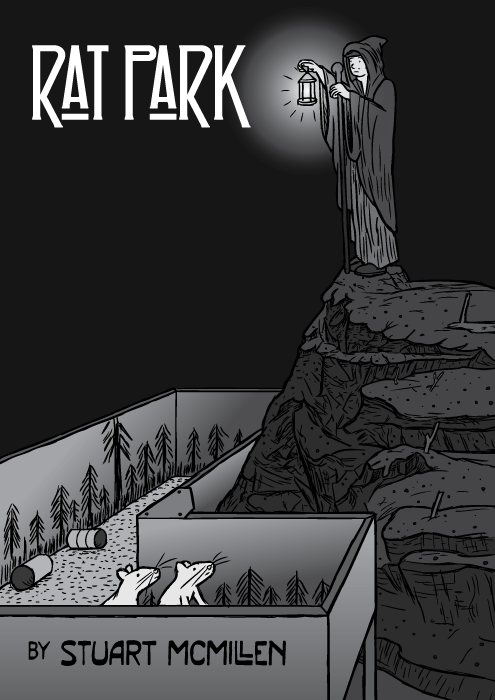

User Controls
Happiness
-
2018-01-30 at 7:21 PM UTC
Originally posted by Open Your Mind Rat Park was a study into drug addiction conducted in the late 1970s (and published in 1981) by Canadian psychologist Bruce K. Alexander and his colleagues at Simon Fraser University in British Columbia, Canada.
Alexander's hypothesis was that drugs do not cause addiction, and that the apparent addiction to opiate drugs commonly observed in laboratory rats exposed to them is attributable to their living conditions, and not to any addictive property of the drug itself.[1]
To test his hypothesis, Alexander built Rat Park, a large housing colony, 200 times the floor area of a standard laboratory cage. There were 16–20 rats of both sexes in residence, food, balls and wheels for play, and enough space for mating.[2] The results of the experiment appeared to support his hypothesis.
In Rat Park, the rats could drink a fluid from one of two drop dispensers, which automatically recorded how much each rat drank. One dispenser contained a morphine solution and the other plain tap water.
Alexander designed a number of experiments to test the rats' willingness to consume the morphine. The Seduction Experiment involved four groups of rats. Group CC was isolated in laboratory cages when they were weaned at 22 days of age, and lived there until the experiment ended at 80 days of age; Group PP was housed in Rat Park for the same period; Group CP was moved from laboratory cages to Rat Park at 65 days of age; and Group PC was moved out of Rat Park and into cages at 65 days of age.
The caged rats (Groups CC and PC) took to the morphine instantly, even with relatively little sweetener, with the caged males drinking 19 times more morphine than the Rat Park males in one of the experimental conditions. The rats in Rat Park resisted the morphine water. They would try it occasionally—with the females trying it more often than the males—but they showed a statistically significant preference for the plain water. He writes that the most interesting group was Group CP, the rats who were brought up in cages but moved to Rat Park before the experiment began. These animals rejected the morphine solution when it was stronger, but as it became sweeter and more dilute, they began to drink almost as much as the rats that had lived in cages throughout the experiment. They wanted the sweet water, he concluded, so long as it did not disrupt their normal social behavior.[1] Even more significant, he writes, was that when he added a drug called Naloxone, which negates the effects of opioids, to the morphine-laced water, the Rat Park rats began to drink it.
In another experiment, he forced rats in ordinary lab cages to consume the morphine-laced solution for 57 days without other liquid available to drink. When they moved into Rat Park, they were allowed to choose between the morphine solution and plain water. They drank the plain water. He writes that they did show some signs of dependence. There were "some minor withdrawal signs, twitching, what have you, but there were none of the mythic seizures and sweats you so often hear about …"[2]
Alexander believes his experiments show that animal self-administration studies provide no empirical support for the theory of drug-induced addiction. "The intense appetite of isolated experimental animals for heroin in self-injection experiments tells us nothing about the responsiveness of normal animals and people to these drugs. Normal people can ignore heroin … even when it is plentiful in their environment, and they can use these drugs with little likelihood of addiction … Rats from Rat Park seem to be no less discriminating."[1]
https://en.m.wikipedia.org/wiki/Rat_Park
There's a cool comic of it too.
-
2018-01-30 at 7:24 PM UTCIf AI takes off and we lose control, I hope it will at least build a "human park" to keep everyone happy.
-
2018-01-30 at 8:07 PM UTC
Originally posted by Open Your Mind Rat Park was a study into drug addiction conducted in the late 1970s (and published in 1981) by Canadian psychologist Bruce K. Alexander and his colleagues at Simon Fraser University in British Columbia, Canada.
Alexander's hypothesis was that drugs do not cause addiction, and that the apparent addiction to opiate drugs commonly observed in laboratory rats exposed to them is attributable to their living conditions, and not to any addictive property of the drug itself.[1]
To test his hypothesis, Alexander built Rat Park, a large housing colony, 200 times the floor area of a standard laboratory cage. There were 16–20 rats of both sexes in residence, food, balls and wheels for play, and enough space for mating.[2] The results of the experiment appeared to support his hypothesis.
In Rat Park, the rats could drink a fluid from one of two drop dispensers, which automatically recorded how much each rat drank. One dispenser contained a morphine solution and the other plain tap water.
Alexander designed a number of experiments to test the rats' willingness to consume the morphine. The Seduction Experiment involved four groups of rats. Group CC was isolated in laboratory cages when they were weaned at 22 days of age, and lived there until the experiment ended at 80 days of age; Group PP was housed in Rat Park for the same period; Group CP was moved from laboratory cages to Rat Park at 65 days of age; and Group PC was moved out of Rat Park and into cages at 65 days of age.
The caged rats (Groups CC and PC) took to the morphine instantly, even with relatively little sweetener, with the caged males drinking 19 times more morphine than the Rat Park males in one of the experimental conditions. The rats in Rat Park resisted the morphine water. They would try it occasionally—with the females trying it more often than the males—but they showed a statistically significant preference for the plain water. He writes that the most interesting group was Group CP, the rats who were brought up in cages but moved to Rat Park before the experiment began. These animals rejected the morphine solution when it was stronger, but as it became sweeter and more dilute, they began to drink almost as much as the rats that had lived in cages throughout the experiment. They wanted the sweet water, he concluded, so long as it did not disrupt their normal social behavior.[1] Even more significant, he writes, was that when he added a drug called Naloxone, which negates the effects of opioids, to the morphine-laced water, the Rat Park rats began to drink it.
In another experiment, he forced rats in ordinary lab cages to consume the morphine-laced solution for 57 days without other liquid available to drink. When they moved into Rat Park, they were allowed to choose between the morphine solution and plain water. They drank the plain water. He writes that they did show some signs of dependence. There were "some minor withdrawal signs, twitching, what have you, but there were none of the mythic seizures and sweats you so often hear about …"[2]
Alexander believes his experiments show that animal self-administration studies provide no empirical support for the theory of drug-induced addiction. "The intense appetite of isolated experimental animals for heroin in self-injection experiments tells us nothing about the responsiveness of normal animals and people to these drugs. Normal people can ignore heroin … even when it is plentiful in their environment, and they can use these drugs with little likelihood of addiction … Rats from Rat Park seem to be no less discriminating."[1]
https://en.m.wikipedia.org/wiki/Rat_Park
fucking hell talk about boring. i couldn't even read it all. i got nearly a third and thought fuck this.
. -
2018-01-30 at 9:29 PM UTC
Originally posted by NARCassist fucking hell talk about boring. i couldn't even read it all. i got nearly a third and thought fuck this.
.
Basically drugs only really take hold of you if your life sucks, like a rat living in a cage. Interest in / dependence on drugs declines if you are living a good life, like the rats in Rat Park. -
2018-01-30 at 10:35 PM UTCDESPITE ALL YOUR RAGE, YOU'RE STILL JUST A RAT IN A CAGE
-
2018-01-30 at 10:37 PM UTC
-
2018-01-31 at 1:43 AM UTCThat was really interesting Obbe, thanks for bringing it up (and the attribution).
I've always looked at those luxury rehab kinds of places with a measure of disdain but maybe there's something to it. I mean still probably irresponsible if you end up releasing people back into the same conditions but at least we seem to have an animal model that suggests you can treat addiction by improving living conditions. -
2018-01-31 at 2:07 AM UTC
-
2018-01-31 at 5:57 PM UTC
-
2018-01-31 at 7:16 PM UTC
-
2018-01-31 at 7:27 PM UTC
Originally posted by Lanny That was really interesting Obbe, thanks for bringing it up (and the attribution).
I've always looked at those luxury rehab kinds of places with a measure of disdain but maybe there's something to it. I mean still probably irresponsible if you end up releasing people back into the same conditions but at least we seem to have an animal model that suggests you can treat addiction by improving living conditions.
Also the rats seem a lot happier living in Rat Park.
Would people be happier living in a "people park"? -
2018-02-01 at 4:59 AM UTC
-
2018-02-01 at 5:35 AM UTC
-
2018-02-01 at 8:13 AM UTC
-
2018-02-01 at 5:57 PM UTC
